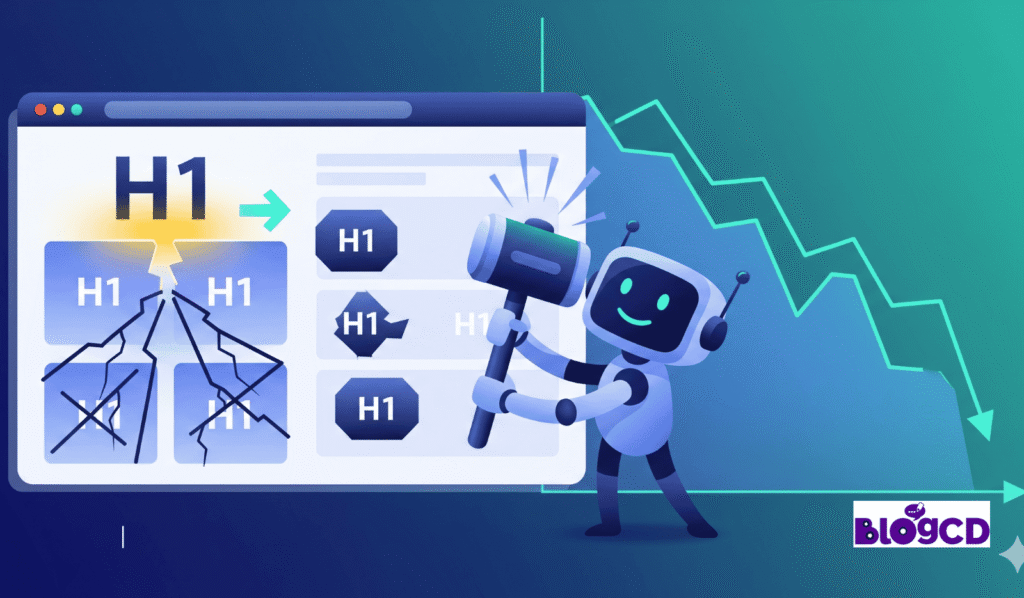When it comes to SEO and content optimization, most people focus on keywords, backlinks, and technical audits. But there’s one often-overlooked issue that can silently hurt your site’s topical authority: multiple H1 tags on a single page.
We recently audited a data platform site and found that nearly every page contained 3–4 H1 tags. The result? Google struggled to identify the primary focus of each page, and even AI tools like ChatGPT had trouble parsing the content for clear answers.
The good news? A simple heading cleanup process helped the site improve user experience and boost engagement by 63%.
The H1 tag is more than just a large headline. It serves as the main identifier of your page’s topic. Think of it as a book title—it tells both humans and machines what the content is about.
- For Google, the H1 gives search crawlers a strong signal about the page’s subject.
- For AI models, it sets the context for understanding the hierarchy of content.
- For users, it creates a first impression and guides them on what they’re about to read.
When you use multiple H1s, you send mixed signals:
- Google may struggle to rank the page because it doesn’t know which topic is dominant.
- AI-based assistants may return irrelevant or incomplete answers.
- Users may feel overwhelmed or confused when scanning the content.
During the audit, we discovered a recurring issue: every page had 3–4 different H1s. For example:
- “Data Insights Platform” (H1)
- “Customer Analytics Features” (H1)
- “Enterprise Data Security” (H1)
Instead of clarifying the topic, this fragmented structure diluted authority. Google and AI tools couldn’t decide whether the page was about data insights, customer analytics, or enterprise security.
The end result? Lower rankings, weaker topical authority, and missed opportunities for organic traffic.
The Heading Cleanup Process (Step by Step)
To fix the problem, we implemented a structured heading hierarchy:
1. Use One Descriptive H1 Per Page
- Keep it unique and focused on the main topic.
- Example: “Enterprise Data Platform for Customer Insights”
- This makes it clear what the page is about without competing signals.
- Use H2s for major sections.
- Use H3s for supporting details.
- Example:
- H1: Enterprise Data Platform for Customer Insights
- H2: Key Features of Our Platform
- H3: Real-Time Analytics
- H3: Predictive Modeling
- H2: Security and Compliance
- H3: Data Encryption
- H3: GDPR & HIPAA Readiness
- H2: Key Features of Our Platform
- H1: Enterprise Data Platform for Customer Insights
3. Write Headings That Match Search Queries
- Instead of generic headings like “Features,” use search-friendly headings such as:
- “Best Data Analytics Features for Enterprises”
- “How Our Platform Ensures Enterprise-Grade Security”
- This mirrors what users type into Google, improving both SEO and readability.
4. Make Headings Scannable and Specific
- Users skim. Your headings should tell the story even without reading the full text.
- Avoid jargon. Focus on clarity and intent.
The Results: 63% Growth in Engagement
After restructuring the heading hierarchy, the site experienced:
- 63% increase in engaged sessions
- More time spent on key product pages
- Higher clarity in how AI tools like ChatGPT parsed the content
Why? Because everyone benefited:
- Google understood the topical hierarchy.
- AI systems extracted accurate answers.
- Visitors found the content easier to scan, navigate, and trust.
Why Clear Content Hierarchy Matters for EEAT
Google’s EEAT framework (Expertise, Experience, Authoritativeness, Trustworthiness) rewards content that is clear, credible, and structured.
A well-defined heading structure signals:
- Expertise → You know the exact scope of your topic.
- Experience → You anticipate user queries in your headings.
- Authoritativeness → Your content flows logically like a trusted resource.
- Trustworthiness → Users can easily scan, verify, and understand your message.
Final Thoughts
If your site is struggling with topical authority or poor engagement, check your headings.
Using multiple H1 tags might seem harmless, but it can confuse both search engines and readers. By committing to one descriptive H1 per page and structuring your content with consistent H2s and H3s, you make your site more understandable to Google, AI, and human visitors alike.
👉 Remember: Clear hierarchy helps everyone.

